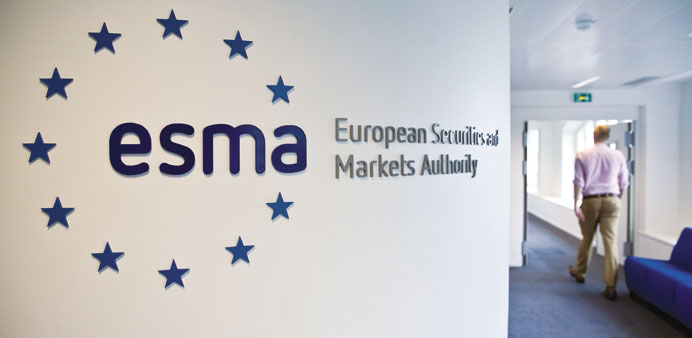A visitor passes a sign in the lobby of the European Securities and Markets Authority’s (ESMA) headquarters in Paris. ESMA, an EU watchdog, will publish about 400 pages of draft rules for the biggest shake-up of the bloc’s securities market in history to increase transparency and investor protection.
The second round of a battle between banks and bourses kicks off this week when European Union regulators publish proposals for the biggest shake-up of the bloc’s securities market in history to increase transparency and investor protection.
The 28-country EU approved a new securities law this year to apply lessons from the 2007-09 financial crisis, and play regulatory catch-up with faster technology such as high-frequency trading.
The head of the watchdog setting out the plans has called the revision the biggest change ever for EU markets as it toughens up rules for share trading, and pulls bonds, derivatives and commodities under the regulatory net. On a broader level, it aims to increase the role of markets in funding economic growth and make the EU capital market better able to compete with the US and Asia with a single set of rules that makes it easier to trade across the continent.
The law updates the bloc’s Markets in Financial Instruments Directive, or MiFID, that was introduced in November 2007 and focused on unleashing competition in share trading.
As soon as today, the European Securities and Markets Authority (ESMA), an EU watchdog, will publish about 400 pages of draft rules to implement MiFID II by early 2017.
“We should realise how big the change is as a result of MiFID II,” ESMA Chairman Steven Maijoor told the Reuters Regulation Summit in April. “This all contributes to a better functioning capital market. In terms of the longer-term wish to improve non-bank funding, the real big development will be MiFID II,” he added.
The proposals are likely to put banks and bourses into conflict over curbs that will be imposed on off-exchange or anonymous trading. Banks and big investors often prefer this “dark” trading for large orders and say trading on an exchange will be more costly and make such orders harder to execute.
How the limits are put in place will shape business models at big cross-border banks and trading platforms as exchanges push for the toughest rules possible.
Another contentious issue is how the proposals will increase competition in the clearing of derivatives like credit default swaps, to make the market less risky.
The EU plans would allow banks to shop around for clearing houses rather than being limited to the house of the exchange they have traded upon.
ESMA will also have to develop limits on how big a slice of the market a trading house can have in commodities in order to avoid “speculation” or undue influence on prices.
Leaks so far of ESMA’s proposals have contained no surprises and are in line with the primary law passed by the European Parliament, but key parts will have to be fleshed out after the public consultation which follows the publication of the plans. “There is going to be a lot of debate around how to make sure the transparency standards for non-equities will be appropriate,” a banking industry official said. “We have not seen anything that immediately jumps out as worrying.”
Other industry officials, however, fully expect attempts to reopen battles seen in the primary lawmaking phase. The law was rushed through in the European Parliament before it went into recess ahead of this week’s elections.
“When you make last-minute deals, you make compromises you would not make if you would have had more time so there is likely to be pressure to change things,” said Sean Tuffy, a senior vice president at Brown Brothers Harriman. “The new open access to clearing provision, which was a highly contentions point during the drafting of MiFID 2, is one area that we should expect to see pressure to change,” Tuffy said.
ESMA is bracing itself against attempts to reopen old battles and will not be keen to stray beyond the primary law otherwise it could be challenged by the European Parliament and EU states, who can veto the implementing measures.
Banks and others who want to tweak the draft rules will be told to come up with actual data to back their case, which may be a tough challenge given the likely short consultation period.



